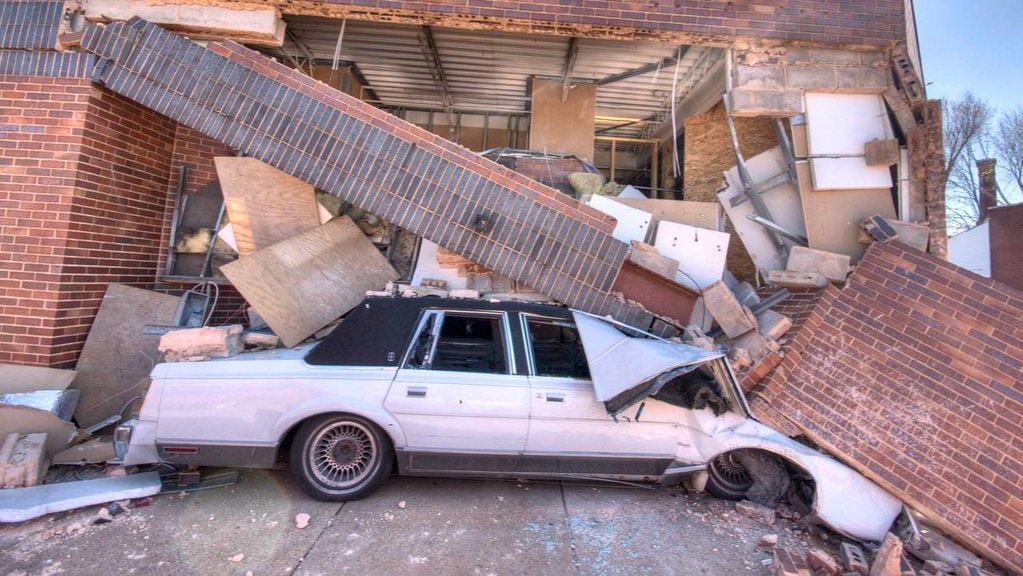Cars Should Not Crash Into Buildings
This article was originally published in The Michigan Daily. It is shared here with permission.
(Source: Flickr/Timothy K Hamilton.)
This year, the Ann Arbor area in Michigan has seen a slew of cars crash into buildings, including a Subway, a pub, an optometrist’s office, a supermarket, and even someone’s house, despite the fact that businesses, homeowners, pedestrians, and society as a whole seem to prefer cars not collide with their buildings. Per one estimate, at least 100 cars crash into buildings every day, and research suggests the death and injury toll of vehicle-in-building crashes is in the thousands.
This is not a standalone phenomenon—it’s a symbol of our increasingly dangerous roadways that injure and kill drivers and pedestrians, whether there’s a building involved or not. Traffic fatality rates, despite declining last year, remain among the highest they’ve been in the past decade. In the first six months of 2023, 21,130 people died in motor vehicle crashes. Roads ought to be designed to protect human life first, not to misguidedly focus on rapidly pushing cars from one destination to the next through residential areas.
In most of the United States, roads are measured using a metric called “level of service.” Transportation departments grade roads from A through F based on the speed at which vehicles can pass through an area. Of the five Ann Arbor-area crashes referred to prior, four occurred on wide, fast-moving roads. The fifth was on a neighborhood street.
These wide streets can be considered “stroads.” A stroad combines the functionality of a street (a place for people and businesses to interact) with the abilities of a road (a high-speed route between people and places). From a safety perspective, a stroad combines the worst of both worlds, leading to increased conflicts between human interaction and car use, thus increasing the probability that crash might occur. A stroad’s width also encourages drivers to speed, a major contributing factor in 29% of all traffic fatalities.
Historically, crashes have been interchangeably referred to as “accidents,” partially because unlike “crash,” “accident” has no denotation of responsibility. As evidenced by my exclusive use of the term “crash” in this column, it’s my belief that every collision has a culprit: usually society as a whole. Crashes are avoidable.
One-fifth of car–building crashes are caused by “pedal error.” This occurs when a driver presses the accelerator instead of the brake pedal, resulting in a crash. Technological improvements in forward-collision mitigation can help reduce this share of car–building crashes, and speed limits can be lowered to reduce the severity of collisions. Humans, not cars, should be put first in the design of our transportation.
To be fair, safety is already considered when building roads. One example is the “clear zone,” an “unobstructed, traversable roadside area” that allows drivers to stop or regain control of their vehicles. In practice, though, techniques used to make roadways “safer” instead just allow vehicles to funnel through faster, without encountering other cars—like when someone uses a clear zone to pass the person in front of them. Furthermore, these types of “safety” features—making roadways wider, faster, and easier for car travel—are often at the expense of transit riders, pedestrians, and cyclists.
We’re halfway through the time period for Ann Arbor’s Vision Zero commitment. The city promised to eliminate fatalities and serious injuries from traffic crashes by 2025. Since this commitment was made, crashes have slightly declined, aligning with national trends. Even so, the total number of incapacitating injuries has nearly doubled in the last year, while the total number of non-incapacitating injuries remains largely unchanged.
Ann Arbor’s government promises to use “speed management” tools, such as speed tables and chicanes, to reduce the dangers posed by roads. These interventions have been proven to make roads safer. Area-wide traffic calming has been shown to reduce child pedestrian injuries. A study reviewing traffic-calming schemas in different countries showed constant decreases in road traffic deaths and injuries.
While powerful, this implementation is coming too late. Roads ought to be made safer at initial construction by default, not retroactively, in a months-long engagement process. If Ann Arbor is truly committed to Vision Zero, its government must take concrete steps in fundamentally transforming its roadways. When streets are resurfaced or upgraded, improving safety should be an automatic consideration. While we may be left with our stroads for decades to come, we can retrofit them to make them friendlier to human life.
To prevent future vehicle–building collisions, the aforementioned supermarket added bright yellow bollards protecting their parking lot. It’s unacceptable that a private business needs to build their own public infrastructure to keep their business safe, but it does show that solutions to stop these types of crashes have potential. Traffic violence must be physically impossible. Adopting a zero-tolerance policy must mean zero tolerance—even one fatality or one injury is unacceptable.
Five vehicle–building crashes does not seem to be a large number. In the context of all crashes nationwide, or even just Ann Arbor, it is not. Even so, all these crashes, not just the ones that happen with buildings, are individual and avoidable tragedies, and ones we must permanently solve.
Abdulrahman Ateya writes about urban issues for The Michigan Daily. He can be reached at ateya@umich.edu.




Fletcher Williams was hit by three cars in a 13-month period — all within a half-mile radius in Bradenton, Florida. And he’s only one of many crash victims. The design of these streets is inhumanely dangerous and must be changed.